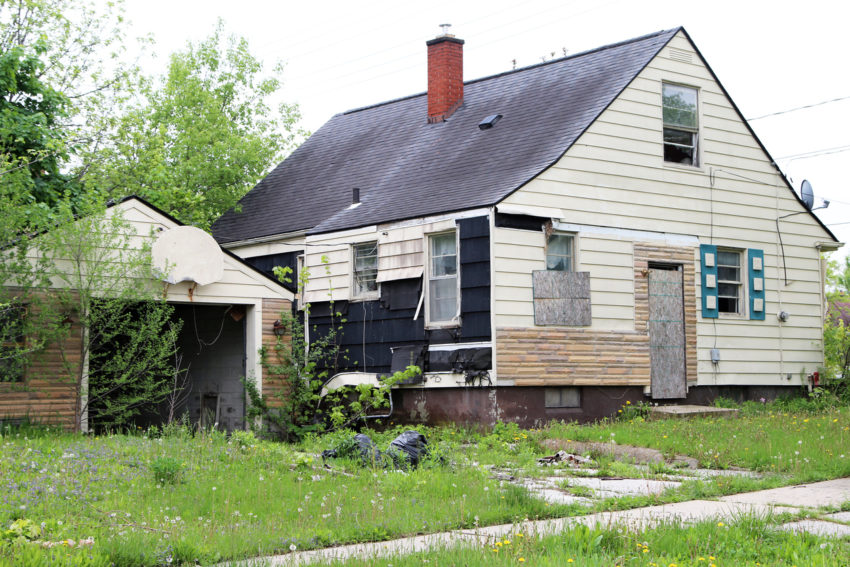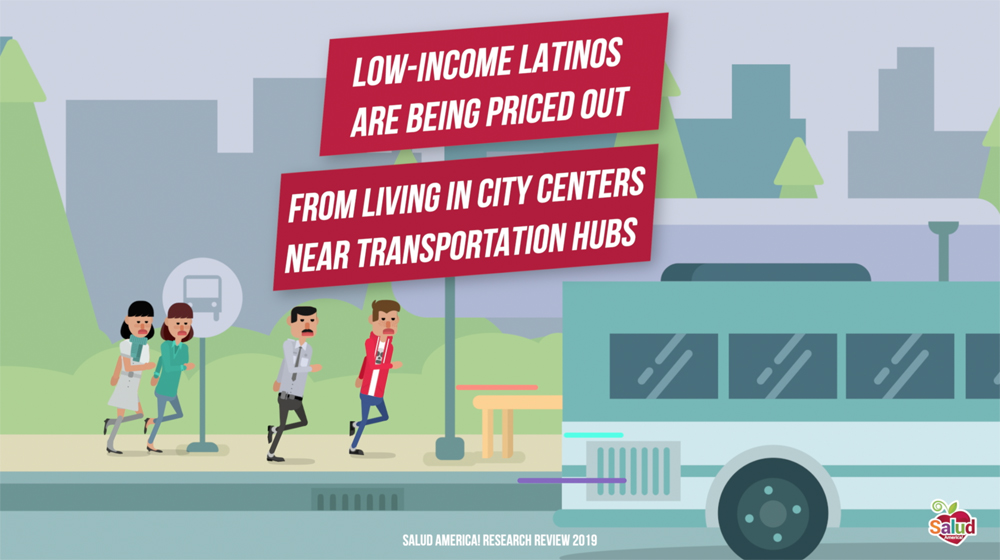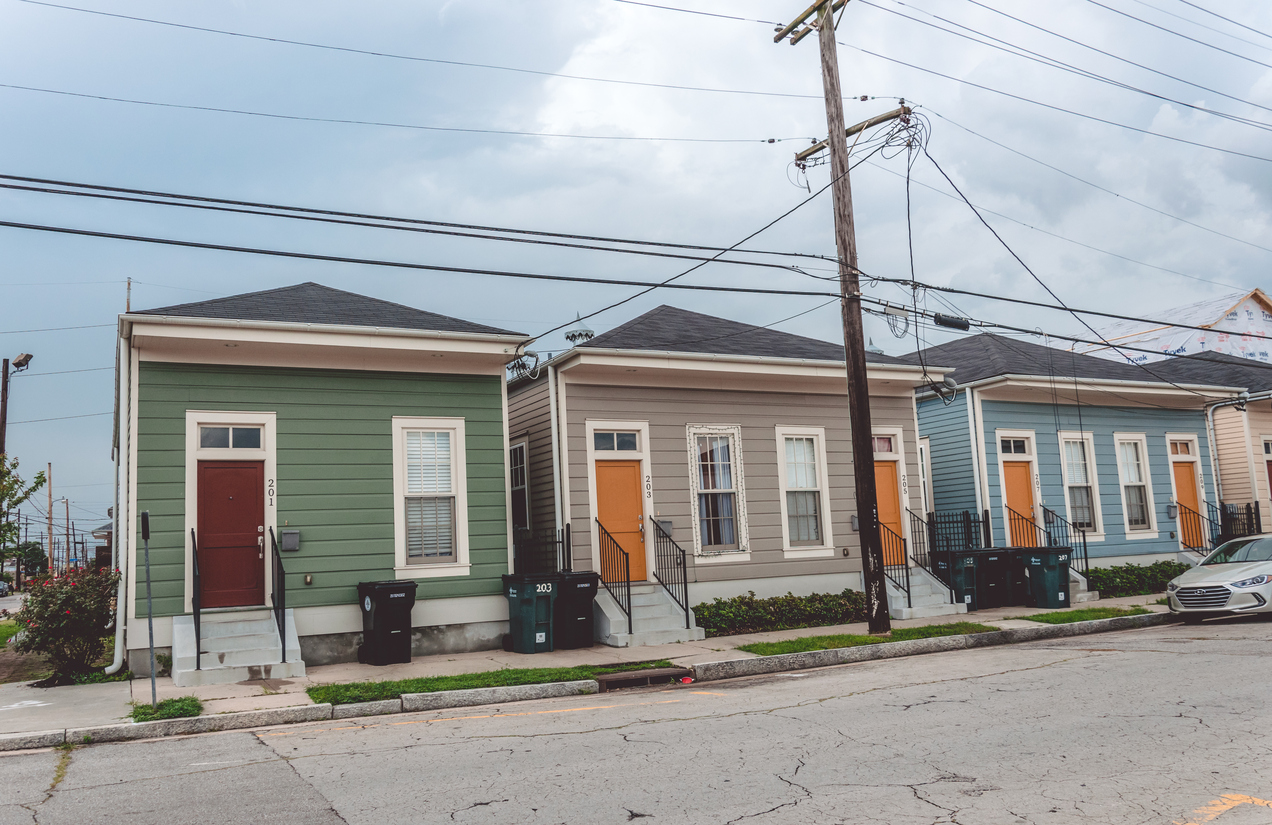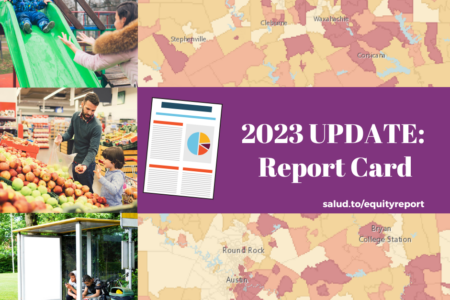
Share On Social!
This is part of the Salud America! The State of Latinos and Housing, Transportation, and Green Space: A Research Review »
Summary
A pattern of Latino migration to small town and rural areas in the Southeast and Midwest instead of to traditional urban centers has led to the formation of isolated, segregated rural Latino communities with unique housing and transportation needs.
The Latino Population Shift: From Urban to Rural
Real estate and transportation trends have shown two prominent residential shifts among Latinos. First of all, in urban areas, Latinos are living farther from transport hubs and amenities, where housing is more affordable. Secondly, a large number of Latinos are migrating into new areas where jobs are available and rents are more affordable, primarily to non-urban areas in the South and Midwest, instead of to traditional urban centers [8, 10–12, 19, 35].
Latino Workers Priced Out from City Centers
The “suburbanization” of Latinos in urban areas is well documented; instead of viewing this as Latinos moving into privileged, affluent suburbs, it must instead be understood as low-wage workers being “priced out” from city centers and pushed into lower-cost areas further from transportation centers and high-quality amenities, squeezed into non-affluent city edges and suburban spaces.
 One study of low-income Latino residents of Round Lake Beach, a near suburb of Chicago, Illinois, directly asked why those who had moved from a municipality of the Chicago metropolitan area chose to move to Round Lake, and 83% chose “availability of affordable housing” as the number one reason over other choices including better neighborhood amenities, safety, presence of family or friends, cultural comfort, or proximity to employment [36].
One study of low-income Latino residents of Round Lake Beach, a near suburb of Chicago, Illinois, directly asked why those who had moved from a municipality of the Chicago metropolitan area chose to move to Round Lake, and 83% chose “availability of affordable housing” as the number one reason over other choices including better neighborhood amenities, safety, presence of family or friends, cultural comfort, or proximity to employment [36].
Displacement Also Pushes Latinos into Rural Areas
As mentioned earlier, displacement caused by neighborhood revitalization projects has been an ongoing problem in many Latino communities [12–15]. Public investment in low-income communities to address issues of insufficient transportation, diminished economic activity, high crime rates, or to develop new green spaces, can often lead to improved quality of life for residents, but it can also increase property values in the area [12, 37].
Those who own their homes benefit by gaining equity and building wealth, but if incomes don’t increase at the same rate as property values (and in most cases, they don’t), housing becomes less affordable, and residents of the community—particularly renters—cannot keep up with housing costs [12, 16]. As a result, these residents then have to move where rents are lower—often farther from where development has occurred, meaning to areas where transport is less accessible, crime rates are higher, and access to green space, healthy foods, and medical and social services is diminished [15]. Add to this the burden of losing one’s social networks and cultural base, and the effects of displacement can be life-altering.
 Furthermore, in many Latino communities, residents are experiencing the effects of gentrification that result from successful neighborhood revitalization. In this case, gentrification is defined as “a type of neighborhood change in which real estate appreciation leads to involuntary displacement and significant cultural change”[12].
Furthermore, in many Latino communities, residents are experiencing the effects of gentrification that result from successful neighborhood revitalization. In this case, gentrification is defined as “a type of neighborhood change in which real estate appreciation leads to involuntary displacement and significant cultural change”[12].
If a property developer, someone who buys land and builds on it, sees an opportunity to profit by targeting a wealthier demographic, for example through development of a new green space or recreation area near a prime transport hub, the community-based institutions and small businesses that were once central to the identity of that neighborhood must change their target clientele or close their doors. When a neighborhood changes, its culture is often lost [12, 14]. Strategies for mitigation of displacement and gentrification in Latino neighborhoods will be discussed later in this review.
For many Latinos, living in urban centers is not sustainable if they cannot afford a place to live or easy way to get to work [11, 35]. Alternatively, transportation costs from outside the urban center can be too high, and public transport may not be available, may take too long, or may not run at the hours needed based on the type of employment [9].
Rural Latino Population Rapidly Growing
Census data has shown that Latinos have been demonstrating new settlement patterns over the past 30 years.
A greater number of Latinos are bypassing the traditionally Latino gateway cities of Miami, New York, Chicago, Houston, and Los Angeles, and are instead settling where jobs in agriculture, construction, and the service industry are plentiful and affordable housing is made available, most commonly by employers. This has primarily been driven by immigrant Latinos, though native-born Latinos are joining the “Latino migration” as well [19].
Since 1990, the Latino population in the rural United States has more than doubled [38].
Within the new destination states of Colorado, Florida, Georgia, Illinois, Idaho, Kansas, North Carolina, Utah, and others primarily in the Southeast and Midwest, Latinos are settling in areas where cheap labor is recruited [10].
The “new Latino ‘pioneers’ to these destinations are often drawn by the availability of low-skilled jobs, which they learn about from family and friends. This leads to clustering for both housing affordability and social networking reasons” [19]. In many cases, migrant workers or other temporary Latino employees began the influx of the Latino “pioneers,” who established the new communities in these areas. Interestingly, in these new, non-urban destinations, Latino communities seem to be more segregated from non-Latino communities than in more traditional urban locales [10, 19, 35].
Segregation Is an Issue in New Latino Destinations
A 2010 study published in Social Science Research examined the extent to which Latino immigrants became spatially incorporated into the communities in which they settled [35].
 Overall, it was found that Latino segregation rates were highest when they settled into new destinations lacking established Latino communities, particularly in suburban and rural areas. A greater incidence of manufacturing and service jobs was also associated with higher levels of Latino-white segregation, as were higher numbers of foreign-born Latinos and higher poverty rates [35].
Overall, it was found that Latino segregation rates were highest when they settled into new destinations lacking established Latino communities, particularly in suburban and rural areas. A greater incidence of manufacturing and service jobs was also associated with higher levels of Latino-white segregation, as were higher numbers of foreign-born Latinos and higher poverty rates [35].
New Latino communities were overrepresented in the South and Midwest, while established communities were located primarily in the West [35]. Another study confirms this finding, demonstrating that between 2000 and 2010, Latino neighborhood segregation rates across the United States have actually increased, especially in emerging markets in the Southeast and Midwest [19]. In contrast, urban areas that have traditionally attracted large Latino populations, such as Chicago, San Antonio, New York, Miami, Phoenix, and Houston, are seeing Latino segregation declines [19].
These trends indicate that Latinos in the “new Latino destinations” are developing novel types of semi-isolated Latino communities that have specific needs for housing, transport, and green spaces, and policymakers will have to become informed regarding how to best serve these communities. Data on these communities is limited and must be gathered to better inform policymakers on these issues.
Rural Latino Population Dynamics
In many of the “new Latino destinations,” Latinos live in both socially and spatially excluded communities [10, 35]. Work by Mendez and Nelson specifically studied the settlement dynamics of Latino communities that have developed in the South, one in a larger Virginia town (population ~96,000) and one in rural Georgia (population ~ 16,000) [10]. In both cases, these areas have been marked by “rural gentrification,” defined as when “wealthy, overwhelmingly white, ex-urban amenity migrants attracted by scenic natural settings, abundant recreational opportunities (including golf), and appealing historic or bucolic landscapes” settle in an area [10]. The arrival of these amenity migrants has driven demand for low-wage workers to build and maintain the residential landscapes, and to provide the services to support the quality of life sought by the new residents.
Significantly, however, the Latino newcomers who are recruited or attracted by the work in these areas cannot afford the cost of independent housing in these gentrified markets, and accessing low-cost housing in these contexts is a challenge. Of note, this study was not of migrant or seasonal workers, but of Latinos who had chosen to settle in the area long-term.
In both the town and the rural environment, the study authors found that workers were often provided employer-furnished housing, or they struggled to access dispersed low-quality, low-cost rentals [10]. In each case, this left the Latino employees completely dependent upon shared rides from employers, as few or none could afford cars, walking, biking, or very limited public transport (if any) to get to work.
Furthermore, the workers’ ability to navigate the spaces of everyday life was completely inhibited, as their homes were isolated from commercial, educational, and social networks [10]. Improvements in public transportation options, especially those that are suitable for low-income individuals in non-urban settings, such as complete streets, greenways, and bike routes, could improve living conditions for Latinos in these communities.
While a limited amount is known about the needs of the Latino communities forming in these new destinations, community activism will be required to ensure equitable neighborhood development in these new gateway destinations.
Policymakers need to ensure affordable housing is made available in rural areas and enforce equitable rental agreements and maintenance requirements. Effective methods for organizing and gaining support from community members may prove essential to move toward more equitable housing, transportation, and green space policies in these “new Latino destinations” as well as in traditional urban Latino communities, as will be discussed further in this review.
Quick links from our Research Review »
More from our Research Review »
- Executive Summary
- Introduction & Methods: Latino Housing, Transportation, and Green Space
- Research: Latino Families Burdened by Housing Costs, Eviction
- Research: Latino Rural Migration Led to Housing, Transportation Inequities
- Research: Latinos Face Big Public Transportation Challenges
- Research: Latino Communities Lack Accessible Green Space
- Strategy: How to Increase Affordable Housing in Latino Communities
- Strategy: How Transit-Oriented Development Benefit Latinos
- Strategy: Improve Public Transit to Improve Latino Quality of Life
- Strategy: Green Space Projects Can Boost Latino Health
- Strategy: Latino Community Involvement Can Spur Environmental Justice
- Policy Implications: Latino Housing, Transportation, and Green Space
- Future Research Needs: Latino Housing, Transportation, and Green Space
References for this section »
8. Calderon, M. (2017). State of Hispanic Homeownership Report. Hispanic Wealth Project. Retrieved from https://nahrep.org/shhr/
10. Mendez, J. B., & Nelson, L. (2016). Producing “Quality of Life” in the “Nuevo South”: The Spatial Dynamics of Latinos’ Social Reproduction in Southern Amenity Destinations. City & Society, 28(2), 129–151. doi:10.1111/ciso.12079
11. Nguyen, M. (2015). The Intersection of Immigration and Housing Policies: Implications for the U.S. Housing Market and Economy. Housing Policy Debate, 25, 1–3.
12. National Association for Latino Community Asset Builder (NALCAB). (2018). NALCAB’s Guide to Equitable Neighborhood Development. National Association for Latino Community Asset Builders. Retrieved from https://www.nalcab.org/wp-content/uploads/2018/02/NALCAB_GuideToEquitableNeighborhoodDevelopment_Final.pdf
13. Sandoval, G. F. (2015). Transit Oriented Development and Equity in Latino Neighborhoods: A Comparative Case Study of MacArthur Park (Los Angeles) and Fruitvale (Oakland). National Institute for Transportation and Communities. Retrieved from https://pdxscholar.library.pdx.edu/cgi/viewcontent.cgi?article=1064&context=trec_reports
14. Sandoval, G. F. (2016). Making Transit-Oriented Development Work in Low–Income Latino Neighborhoods: A comparative case study of Boyle Heights, Los Angeles and Logan Heights, San Diego (pp. 1–74). National Institute for Transportation and Communities.
15. Greenfield, J. (2016). For Latino activists, transportation justice means factoring in immigration and gentrification. Chicagoreader.com. Retrieved from https://www.chicagoreader.com/chicago/latino-activists-transportation-justice-concerns/Content?oid=24259928
16. Merck, A. (2018). San Antonio Leaders Weigh Plan to Triple Funding for Affordable Housing. Salud America! Retrieved from https://salud-america.org/san-antonio-leaders-weigh-plan-to-triple-funding-for-affordable-housing/
19. Frey, W. H. (2010). Census Data: Blacks and Hispanics Take Different Segregation Paths, in State of Metropolitan America. Brookings: Brookings.
35. Lichter, D. T. (2010). Residential segregation in new Hispanic destinations: Cities, suburbs, and rural communities compared. Social Science Research, 39(2), 215–230.
36. Duque, C. (2010). Latino Immigrants in the United States Why the Suburbs? Why the Round Lake Area? A Case Study. College of Liberal Arts & Social Sciences Theses and Dissertations. Retrieved from https://via.library.depaul.edu/etd/20/
37. Fullwood, S. (2016). The United States’ History of Segregated Housing Continues to Limit Affordable Housing. Center for American Progress. Retrieved from https://www.americanprogress.org/issues/race/reports/2016/12/15/294374/the-united-states-history-of-segregated-housing-continues-to-limit-affordable-housing/
38. Turner, K., Wildsmith, E., Guzman, L., & others. (2016). The Changing Geography of Hispanic Children and Families. National Research Center on Hispanic Children & Families.
By The Numbers
56.9
percent
of Latinos are "housing cost burdened"



